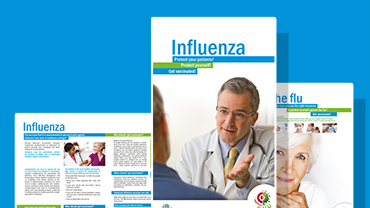Influenza virus characterisation, Summary Europe, November 2018
This is the second report for the 2018–19 influenza season. As of week 48/2018, only 2 061 influenza detections across the WHO European Region had been reported.
Executive Summary
This is the second report for the 2018–19 influenza season. As of week 48/2018, only 2 061 influenza detections across the WHO European Region had been reported. Detections were made up of 90.4% type A viruses, with A(H1N1)pdm09 prevailing over A(H3N2), and 9.6% type B viruses, with 10 (90.9%) of 11 ascribed to a lineage being B/Yamagata.
One EEA country, Norway, has shared influenza-positive specimens with the London WHO CC, the Francis Crick Worldwide Influenza Centre (WIC), since week 40/2018. Hence, the main focus of this report is phylogenetic analyses of HA genes of globally collected seasonal influenza viruses with recent collection dates (1 June 2018 or later) that international laboratories had submitted to the GISAID EpiFlu database by 10 December 2018.
HA genes of A(H1N1)pdm09 viruses continue to fall within subclade 6B.1, defined by HA1 amino acid substitutions S84N, S162N and I216T, represented by the vaccine virus A/Michigan/45/2015, with all recently circulating viruses having additional substitutions of S74R, S164T and I295V. The six characterised viruses from Norway all fell in subclade 6B.1 and were antigenically similar to the vaccine virus.
The great majority of recently circulating A(H3N2) viruses have HA genes falling in subclade 3C.2a2 and subgroup 3C.2a1b, as seen for the seven viruses characterised by the WIC (six 3C.2a1b and one 3C.2a2). Due to a lack of HA activity, the seven viruses could not be characterised antigenically by HI assay; however, based on previous HI analyses performed with post-infection ferret antisera raised against similar viruses, those raised against subgroup 3C.2a1b viruses induced responses that gave cross-subclade reactivity while those raised against subclade 3c.2a2 viruses gave more subclade-specific reactivity.
All 80 B/Victoria-lineage viruses with collection dates from 1 June 2018 had HA genes that encoded HA1 amino acid substitutions of I117V, N129D and V146I and fell within a subclade of clade 1A (the B/Brisbane/60/2008 clade). However, 16 and 49 of these, respectively, fell in groups defined by deletions of three (Δ162-164) or two (Δ162-163) amino acids in HA1. Previous HI analyses with panels of post-infection ferret antisera have shown these three groups of viruses to be antigenically distinguishable and a Δ162-163 virus, B/Colorado/06/2017, has been recommended for use in trivalent vaccines for the current northern and upcoming southern hemisphere influenza seasons.
All 73 B/Yamagata-lineage viruses with collection dates from 1 August 2018 had HA genes that fell within the B/Phuket/3073/2013 vaccine virus clade (clade 3) and encoded HA1 amino acid substitutions of L172Q and M251V, with some having additional substitutions. Previous HI analyses with post-infection ferret antisera raised against B/Phuket/3073/2013 have shown such viruses to be antigenically similar to the vaccine virus which has been recommended for use in quadrivalent vaccines for the current northern and upcoming southern hemisphere influenza seasons.
Download

Factsheet about seasonal influenza
General disease information for public health experts and the general public on seasonal influenza.
See all reports
More on influenza surveillance
Objectives for integrated surveillance of respiratory viruses at EU level
There are general objectives for integrated surveillance of respiratory viruses in the European Union. These objectives apply to surveillance of influenza, COVID-19, and other respiratory virus infections.







